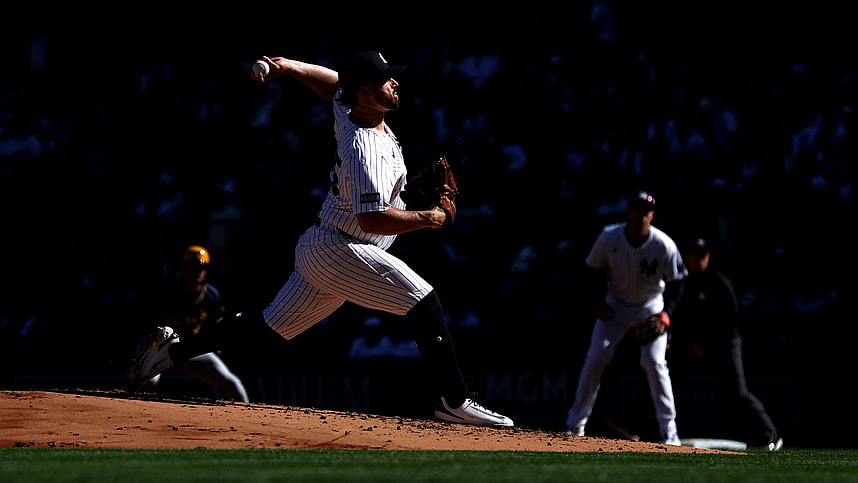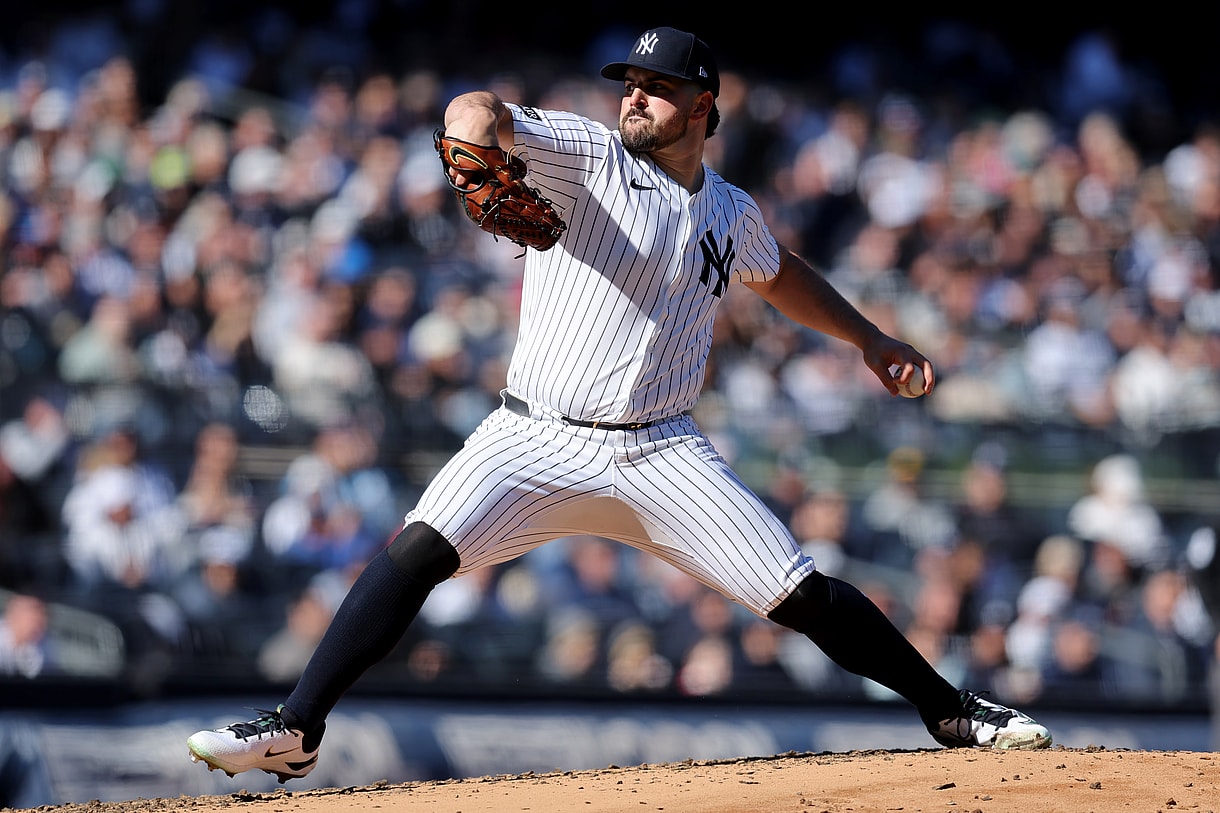
A strong Opening Day start could (temporarily) soothe an aching Spring Training where the Yankees dealt a slew of brutal injuries. As the team jogged onto the field for the first pitch, they did so with 10 different pitchers who were expected to throw MLB innings this year on the injured list. Their best pitcher is gone for the season, their Rookie of the Year winner is out for at least three months, and their top pitching prospect is knocked out for the season (again).
Carlos Rodon was ready to give fans a warm compress on an aching wound, dialing up 5.1 innings of one-run ball, striking out seven of the Brewers he faced. He was a different pitcher to the fastball-slider guy we saw at the start of last season, as Rodon had perhaps his most unique usage rates ever in the 2025 opener. Embracing his brand-new one-seam sinker, the left-hander used six pitches and mixed five consistently from start to finish.
A veteran learning how to pitch in a changing climate, the Yankees are hoping to see more of this Carlos Rodon in 2025.
Carlos Rodon’s Unique One-Seam Sinker Is Truly Disgusting

In the backfields of Spring Training, Matt Blake and Sam Briend seemed to put Carlos Rodon in their pitching lab to concoct a devilish new pitch. We wouldn’t see the big left-hander participate in a single Grapefruit League game from February 27th to March 21st, but the pitcher who emerged is unrecognizable from the one we saw just a few weeks ago. Rodon has developed what’s being dubbed a “one-seam sinker”, which he utilized more and more as he got deeper into his start.
While not the first time Carlos Rodon has featured a sinker in his repertoire, the one he threw back in 2018 is nothing like the one he’s throwing right now. As a pitcher who has struggled with throwing pitches that move away from right-handed hitters, the fact that Rodon developed a reliable changeup was quite the development. The idea of a sinker for someone who struggles to pronate the ball consistently is bad news, it’s why he ditched the pitch and never went back to it after his first few years in the big leagues.
One-seam sinkers don’t function the same way that a regular sinker or two-seamer does, relying less on heavy pronation and more on Seam-shifted wake (SSW) to generate the desired movement. SSW is the concept of using the orientation of a baseball’s seams to create movement by disrupting airflow in its flight path rather than through spin. Throwing a sinker with lots of vertical drop would be hard for someone with an over-the-top delivery like Carlos Rodon, but by letting the seams of the ball do the work, he’s able to throw a truly unique sinker.
READ MORE: Yankees struck gold at the top of the batting order

When sorting by release height, Carlos Rodon is a unicorn compared to the other pitchers averaging as much or more drop on their sinker, as even the ones who are somewhat close in release height have far lower release angles. Rodon is a true high-release over-the-top left-hander, the kind that’s supposed to throw four-seamers at the top of the zone and spin curveballs at the bottom. Instead, he’s throwing a vicious sinker that bears a striking resemblance to what Zack Britton threw with the Orioles and Yankees.
His tenure in the Bronx came to a depressing end as injuries had withered away at the once-dominant reliever, but fans knew that when he was on there were few hitters in the sport that could touch him. The strikeout rates were rarely elite and the walk rates would give you heart palpitations, but they rarely resulted in runs coming across to score. Britton would simply coax a groundball and get two outs in one fell swoop. It was thanks to his one-seam sinker, a pitch that had tons of vertical drop from a higher arm slot and arm angle than hitters were ready to handle.
During his final healthy MLB season in 2020, Zack Britton used his sinker 80% of the time, hitters knew it was coming and he still put up a 1.91 ERA. That’s how good his sinker was, now imagine if someone just casually added a pitch similar to it during Spring Training.

There are a lot of numbers here, but pay attention to the release height, arm angle, and vertical movement. They share the similarities of having high release points and arm angles relative to the depth they get on their sinker, and so while these aren’t identical sinkers, they are similar in what they aim to do. Furthermore, the shape of Carlos Rodon’s sinker will need more than 10 pitches to stabilize, but even in Spring Training, there was a ton of vertical drop relative to the release height.
While he allowed a “hit” on that pitch, that single was the groundball that Paul Goldschmidt needed to take to first himself, a batted ball that Carlos Rodon would happily take with that sinker. Of the 10 he threw, he generated two harmless balls in play, three called strikes, a whiff, and a foul ball before two strikes, meaning he got five strikes in the 10 he threw yesterday. The rest were out of the zone, but that’s an effective first day with a pitch we didn’t see used in a game until his final start of Spring Training and have never seen used in a real MLB game.
Carlos Rodon had a 61.5% GB% in this start; the highest he’s had in any start with the New York Yankees and his highest in nearly six years.
The Yankees Could Have a More Dynamic Carlos Rodon in 2025

Last season we saw Carlos Rodon develop a changeup, leaning on that pitch more and more as the season went on, as he posted a sub-3.00 ERA with a 30% K% after the All-Star Break. It’s been a struggle to get Rodon to come to grips with the flaws in his heavy-fastball approach, as what got him paid $162 million by the Yankees was no longer in vogue. Pitchers are being pushed to throw more and more pitches in their repertoire to keep hitters off of their best stuff. Four-seamers at 95-96 MPH with good ride aren’t special the way they were back in 2022 with improved technology and scouting.
Being unique on the mound results in better run prevention, and to Carlos Rodon’s credit, he’s matured to the point where he’s learning to expand his arsenal. The left-hander used his four-seamer under 30% of the time against the Brewers yesterday and used five different pitches at least nine times, something he hasn’t had to do since he was a floundering prospect with the White Sox. To swallow that pride and become open to change takes guts, and we’re starting to see those effects materialize in the form of excellent results.
He won’t have everything working for him all the time, but even yesterday the four-seamer was not doing what he hoped for. After throwing seven four-seamers in the first inning and just two sliders, Carlos Rodon allowed a home run to Vinny Capra on his fastball and a 103.4 MPH laserbeam single off of Brice Turang off of another fastball right after that. This is where a less mature Carlos Rodon would try overpowering a hitter like Jackson Chourio with a four-seamer that would have sailed into a sea of fans ready to drink their misery away at Billy’s, cursing the $162 million deal in between sips.
Instead, he adjusted. We saw just eight four-seam fastballs the rest of the way, and those fastballs did a great job of climbing the ladder to change eye levels and set up a nasty secondary pitch. That’s pitching, and it’s something Gerrit Cole learned after a 2022 season full of blow-up starts.
READ MORE: Yankees’ Giancarlo Stanton takes big rehab step

Max Fried is the obvious pitcher to replace Gerrit Cole as the Yankees’ ace, but people forget that Brian Cashman paid Carlos Rodon to do that back in 2022. He was paid to be the guy they could put right next to their $324 million ace, and that if something like a UCL tear happened, they had someone in their rotation who could take the ball for Game 1 of a playoff series and dominate. The Carlos Rodon they signed was one who had a repertoire that was quickly on the way out, the sport has begun to rebuke the two-pitch starter.
Upstart right-hander Spencer Strider has been a historically dominant strikeout artist in his young career, but even he had to expand his repertoire to avoid falling behind. A sinker and curveball will be in his mix alongside the four-seamer and slider, but who knows what else the Braves help him add? Nestor Cortes, who the Yankees will face tomorrow, was a below-average starter in 2024 until he added a changeup, as the fastball-cutter mix was too predictable and didn’t catch hitters who could go to a Trajekt Hitting Machine and see 100 pitches identical to his before the game.
Carlos Rodon is not just a new pitcher; he’s a new man. He isn’t planning each and every pitch ahead of time, but he’s got an expanded arsenal and trusts his catcher and the people inside the building to guide him through each of his starts. My bold take was that Carlos Rodon would strike out 30% of batters faced this season, and going back to the All-Star Break of last season, he’s got a 2.82 ERA and a 30.1% K%.
More about: New York Yankees